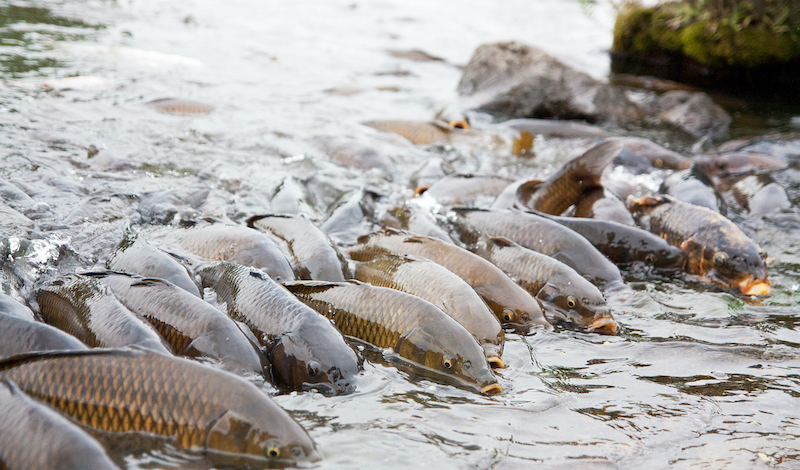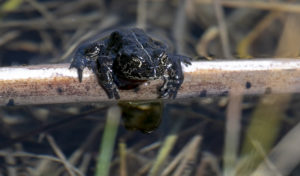
Regulators struggle to keep pace with migration of invasive species to the Great Lakes.
Fear of sharks? So passé. The new underwater terror is far less sexy, and far more ferocious than its top-of-the-food-chain friend.
That terror is the invasive carp. These fish are now considered the “poster child” for invasive species because of the devastating effects they pose for the ecosystems they inhabit.
Invasive carp first entered the United States during the 1970s. Owners of fisheries in the South imported three species of carp from China—bighead, silver, and black—to clean southern aquaculture ponds of parasites, algae, and other weeds. Large floods, however, swept these fish from their controlled habitats into the wide-open Mississippi river basin.
More than 50 years later, invasive carp have become a parasite in U.S. waterways far beyond those they were brought in to fix. They threaten ecosystems because they “out-compete other fish for food and space.” In some rivers, these fish have even killed off all other native species. And some experts think they also lower water quality.
The invasive carp’s invasive presence is felt above the water too. Invasive carp typically weigh between 40 and 60 pounds and are known to jump high into the air, causing injuries to passing boats and water skiers.
For many years, invasive carp have mightily travelled from the Mississippi River toward the Great Lakes basin. As the media has largely ignored the fish’s northern movements, environmental advocates, policymakers, and members of the fishing industry have looked on with fear. These stakeholders understand a bitter reality: if invasive carp make it into the Great Lakes, the region’s $7 billion fishing industry is at risk of an “ecological disaster.”
And without further action, this “if” is about to become a “when.”
In 2019, a few invasive carp were found in the Chicago River just nine miles from Lake Michigan. The U.S. Army Corps of Engineers confirmed through environmental genetic testing that some of the fish had broken through man-made electric barriers set up on a Chicago waterway.
Regulatory interventions have fallen short of stopping the carp from creeping closer to the Great Lakes. Some of these well-intentioned interventions have been reactionary in nature, and others stalled by cost or held up by terminology.
For example, the Lacey Act recognizes all three species of invasive carp as “injurious” species prohibited from interstate transport. But, as some scholars have noted, the Lacey Act contains no sections aimed at proactively containing the fish’s spread. Instead, the law merely labels and raises awareness of the carp’s problematic qualities.
More ambitious proposals to stop the spread of invasive carp have also stalled. In 2004, for example, the U.S. Army Corps of Engineers called for the restoration of the natural divide between Lake Michigan and the Mississippi River. This divide was destroyed in the early 1900s to direct the flow of Chicago’s sewage toward the Mississippi River. Although restoration of the divide would be effective, the idea has yet to be implemented because critics have expressed alarm at its $15 billion price tag.
Moreover, the proposed restoration of the divide has also run into regulatory roadblocks. Due to requirements under the Clean Water Act, the restoration project would require an elaborate waste treatment process to ensure that Chicago’s sewage plants flowing into Lake Michigan would not create health risks.
Some lawyers have found this application of water pollution regulation to be ironic. They argue that invasive carp should also be considered a pollutant with an even more direct effect on the environment than the wastewater treatment
Despite the funding and regulatory hurdles, in November 2021, all 16 U.S. Senators from the Great Lakes demanded that the proposal move forward expeditiously. To date, though, no further action has been taken to advance this proposal.
In its place, a more straightforward solution has taken root. In December 2021, Congress authorized the construction of the Brandon Road Interbasin Project. This project seeks to restrict the invasive carp from entering Lake Michigan where the Des Plaines River ends.
The Illinois and Michigan Departments of Natural Resources have formed an intergovernmental agreement to fund this project. And in January 2022, the federal Infrastructure Investment and Jobs Act allocated $225.8 million to support the effort.
The Brandon Road Interbasin Project is not a perfect substitute for the restoration of the Chicago River divide. The divide would completely sever the fish’s ability to enter the open waters of Lake Michigan while the Project requires the construction of a multitude of technologies to curb the fish’s route to Lake Michigan.
Despite the complexities of construction, interested parties are hopeful about its prospects. But it remains an open question whether construction will finish before the invasive carp reach the open water.



